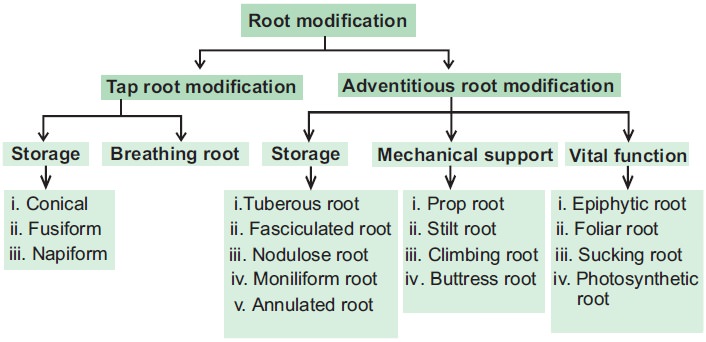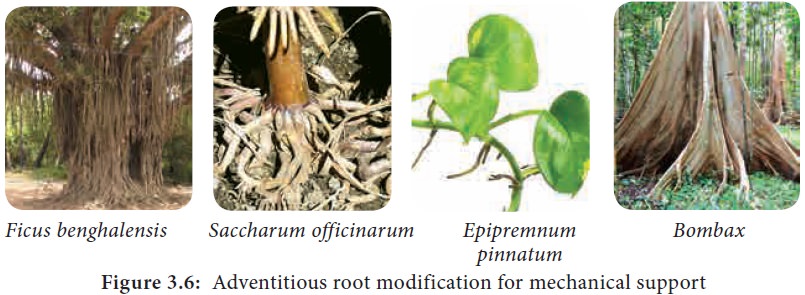Chapter: 11th Botany : Chapter 3 : Vegetative Morphology of Angiosperm
Adventitious root modification
Adventitious root system
Root developing from any part of the plant other
than radicle is called adventitious
It may develop from the base of the stem or
nodes or internodes. Example: Monstera
deliciosa, Ficus benghalensis, Piper nigrum. In most of the monocots the primary root of the seedling is
short lived and lateral roots arise from various regions of the plant body.
These are bunch of thread-like roots equal in size which are collectively
called fibrous root system generally
found in grasses. Example: Oryza sativa,
Eleusine coracana, Pennisetum
americanum.

Adventitious root modification
a. Storage roots
1. Tuberous root
These roots are swollen without any definite shape.
Tuberous roots are produced singly and not in clusters. Example: Ipomoea batatas.
2. Fasciculated root
These roots are in cluster from the base of the
stem Example: Dahlia, Asparagus, Ruellia.
3. Nodulose root
In this type of roots swelling occurs only near the
tips. Example: Maranta (arrow root) Curcuma amada (mango ginger), Curcuma longa (turmeric)

4. Moniliform or Beaded root
These roots swell at frequent intervals giving them
a beaded appearance. Example: Vitis,
Portulaca, Momordica, Basella (Indian
spinach).
5. Annulated root
These roots have a series of ring- like swelling on
their surface at regular intervals. Example: Psychotria (Ipecac)
b. Mechanical support
1. Prop (Pillar) root
These roots grow vertically downward from the
lateral branches into the soil.
Example: Ficus
benghalensis (banyan tree), Indian rubber.
2. Stilt (Brace) root
These are thick roots growing obliquely from the
basal nodes of the main stem. These provide mechanical support.
Example: Saccharum
officinarum, Zeamays, Pandanus,
Rhizophora.

3. Climbing (clasping or clinging) roots
These roots are produced from the nodes of the stem
which attach themselves to the support and help in climbing. To ensure a
foothold on the support they secrete a sticky juice which dries up in air,
attaching the roots to the support. Example: Epipremnum pinnatum, Piper betel,
Ficus pumila.
4. Buttress root
In certain trees broad plank like outgrowths
develop towards the base all around the trunk. They grow obliquely downwards
and give support to huge trunks of trees. This is an adaptation for tall rain
forest trees. Example: Bombax ceiba (Red
silk cotton tree), Ceiba pentandra (white silk cotton tree), Terminalia arjuna, Delonix regia, Pterygota
alata.
c. Vital functions
1. Epiphytic or velamen root
Some epiphytic orchids develop a special kind of
aerial roots which hang freely in the air. These roots develop a spongy tissue
called velamen which helps in
absorption of moisture from the surrounding air. Example: Vanda, Dendrobium, Aerides.
2. Foliar root
Roots are produced from the veins or lamina of the leaf for the formation of new plant. Example: Bryophyllum, Begonia, Zamioculcas.
3. Sucking or Haustorial roots
These roots are found in parasitic plants.
Parasites develop adventitious roots from stem which penetrate into the tissue
of the host plant and suck nutrients.
Example: Cuscuta
(dodder), Cassytha, Orobanche (broomrape), Viscum (mistletoe), Dendrophthoe.
4. Photosynthetic or assimilatory roots
Roots of some climbing or epiphytic plants develop
chlorophyll and turn green which help in photosynthesis. Example: Tinospora, Trapa natans (water chestnut),
Taeniophyllum.
Related Topics
